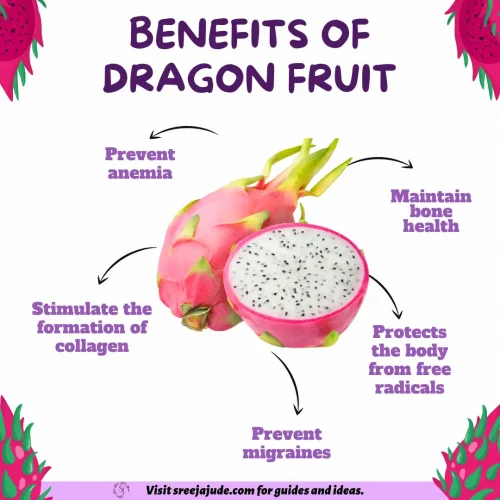
What does Dragon Fruit taste like? | How to Cut and Eat it
What does dragon fruit taste like? How to cut it? and ultimately how to eat it? If these questions are in your mind, then you have come to the right place. Here, I am talking about dragon fruit, its health benefits, and a technique to eat it properly.
What is Dragon Fruit and it’s Types
The dragon fruit also called pitahaya, pitaya or strawberry pear is a beautiful tropical fruit. The fruit earned the name “dragon fruit” due to its pink skin and light green scales, which bear a resemblance to a dragon.
The species Hylocereus undatus, to which the dragon fruit belongs, bears flowers from June to September, which are located at the ends of the sprouts. The flowers are among the largest in the world: they are up to 30 centimeters long and up to 25 centimeters in diameter.
There are three types of Pitahayas. Either the fleshy, scaly shell is:
- pink and the pulp white inside (Hylocereus undatus),
- pink with red flesh (Hylocereus monacanthus) or
- yellow with white pulp (Selenicereus megalanthus)
Most often you can see fruits with a pink-red skin and white pulp. Black seeds are interspersed throughout the fruit. The dragon fruit is mainly cultivated in Asia. Cultivation countries are, for example, Nicaragua, Israel, Vietnam and other Asian countries. The pink alluring species are pretty to look at and have a fresh, often slightly watery aroma. If you eat dragon fruit in large quantities, it can have a laxative effect.
Farmers grow dragon fruit in tropical climates, enabling its continuous availability in stores throughout the year. Moreover, the taste of dragon fruit varies, ranging from slightly sour to sweet, depending on its degree of ripeness. It bears a resemblance to the flavors found in kiwi and watermelons. It is low in sugar in a combination with fiber, which allows the feeling of satiety to be maintained for longer. Ideal for a healthy diet.
The pink, fleshy fruits owe their appearance to their naturally high content of beta-carotene and betalain pigments. This fruit is an alluring fruit that can also be seen more and more often in this country. In this article, learn why it is healthy, what its nutritional values are, and how best to prepare it.
Uncover the Nutritional Facts of Dragon Fruit
The dragon fruit can be viewed as a fruit with a high nutrient density, this fruit has many healthy nutrients and minerals such as iron, magnesium and potassium, as well as fiber. It consists of 90% water. This table also displays the included vitamins.
| Nutritional information | |
|---|---|
| 1 servings per pack | |
| Portion size | 100 |
| Amount per serving | |
| Calories | 50 |
| % Daily value * | |
| Total fat 0.7g | 0% |
| Saturated fatty acids 0g | 0% |
| Trans Fat 0g | |
| Cholesterol 0mg | 0% |
| Sodium 12mg | 1% |
| Total carbohydrates 10.5g | 4% |
| Dietary fiber 1.8g | 1% |
| Total sugar -g | |
| Contains 0g added sugar | 0% |
| Protein -g | |
| Vitamin D -mcg | 0% |
| Calcium 7mg | 1% |
| Iron 1.66mg | 6% |
| Potassium 222mg | 5% |
| Phosphate | 14% |
| Vitamin C 9.2mg | 7% |
*Daily percentages are based on a 2,000-calorie diet. Depending on your calorie needs Your daily values can be higher or lower.
Benefits
| Ingredients | Effect on the body |
|---|---|
| Vitamin B | B vitamins are important for our general well-being. A deficiency in this family of vitamins can lead to exhaustion, tiredness, and loss of vitality |
| Vitamin C | Vitamin C is probably the best-known vitamin. This is involved in numerous metabolic processes and plays an important role in the immune system |
| Vitamin E | This vitamin is a well-known antioxidant and is said to be able to slow down aging processes, among other things. Vitamin E is additionally vital for healthy skin |
| Calcium | Calcium is extremely important for healthy bones and teeth. Calcium is also said to have a positive influence on connective tissue |
| Iron | Iron plays many important roles in the body and is, among other things, responsible for the supply of energy to the cells and for blood formation |
| Phosphorus | Iron plays many important roles in the body and is, among other things, responsible for the supply of energy to the cells and for blood formation |
Discover the Health Benefits of Dragon Fruit
The alluring fruits have a particularly high beta-carotene content and betalain color. These fabrics are also responsible for the eye-catching appearance and pink color. But in addition to the visual aspect, the substances mentioned have other positive effects apart from taste, which make the dragon fruit healthy to eat.
The body can partially convert beta-carotene into vitamin A. This in turn can regulate cell growth, ensure healthy eyes and strengthen eyesight.
The dragon fruit has all these positive effects in common with many other fruits. However, what distinguishes them from the others and thus makes them special are the following characteristics:
1. Fatty Liver
In a study, researchers observed a beneficial effect of reducing fatty liver in higher-weight mice when they administered both white and red varieties of pitaya.
In summary: Animal studies on mice show positive effects. Clinical studies in humans are still not available.
2. Slimming and Weight Loss
Dragon Fruit has a mild sweetness and is low in sugar content. It is also low in calories and rich in fiber. Additionally, it has a high water content, making up about 90% of its composition. With high-fiber foods, a longer feeling of satiety can be achieved, which means that there is a high probability that you will consume fewer calories per day and that you will be able to reduce weight better.
A study of two groups of mice on a high-fat diet, one of which received an extract from dragon fruit, had less weight than the comparison group at the end of the study. Also, this is probably justified by a positive change in the intestinal bacteria.
In summary: Due to its low-sugar and high-fiber property, it makes the dragon fruit with a 90% water content a low-calorie alternative for weight loss.
3. Heart Health
The vitamin B3 content of dragon fruit can help reduce the “bad” LDL cholesterol level. This is important to keep your heart healthy!
Simultaneously, the consumption of dragon fruit has the potential to enhance and increase the level of beneficial HDL cholesterol in the bloodstream. In a 2018 animal study conducted on mice, significant findings emerged. Researchers observed a notable reduction in bad LDL cholesterol levels over a 30-day period when administering powder made from red dragon fruit peel at doses of 50, 100, 150, and 200 mg/kg body weight.
In summary: Although researchers have only tested this on mice and not on humans, it indicates a potential tendency to promote positive cholesterol levels in the blood.
Unproven Claims
We have listed other claims about possible beneficial properties below. We could not find any reliable sources, so these positive properties are not clinically proven or disproved and should be consumed with caution.
- Helps with digestion (possibly via the fiber it contains)
- Manages blood sugar levels (Animal studies have shown positive results, but studies in humans have not been effective)
- Prevents cancer (we did not find any reliable sources for this)
- Maintains eye health
- Combats signs of aging (dragon fruit is found in some creams, but there are no well-founded studies)
In summary: Many of the claims still have to be proven with studies or even investigated or have too small studies to be mentioned.
Know More About How Dragon Fruit Taste Like?
While the pink pitahaya with white pulp tastes neutral but sour and therefore extremely refreshing, the yellow-skinned dragon fruit is the most aromatic. Their aroma is a bit like a mixture of strawberry, pineapple, and mango. However, the fruit tastes most intense with its pink skin and red interior.
Although the three types differ in color and taste, the consistency remains the same, The dragon fruit is always jelly-like. It most closely resembles a gooseberry or kiwi.
How to Eat Dragon Fruit
When sliced or cut into small cubes, the pulp of dragon fruit, which is rich in vitamins, complements fruit salads, muesli, and can also be used as a topping for cakes.
For those who like it, purist simply cut the fruit in half lengthways and spoon it out like a kiwi. In addition, the dragon fruit is prepared in many ways. Some tips and ideas:
- Smoothie together with mango and raspberries
- Dragon jam with figs
- Alluring fruit salad with dragon fruit
- Fruit ice lolly with dragon fruit
- Can be eaten with cheese and fish
- Kebabs with kiwi and apple
- Perfectly goes well with desserts, on ice cream, and in deliciously fruity sauces
How to Cut Dragon Fruit
The dragon fruit is best eaten raw. If it is also cooled, it has a very stimulating effect. The flesh of the best-known type is gray-white and similar to a kiwi, with countless black seeds.
In order to get as much pulp from the dragon fruit as possible, it should be peeled as follows:
- 1 step: The fruit is cut in half and spooned out with a large spoon.
- 2 step: The ends of the fruit are cut off and the skin peeled off.
- 3 Step: Done – the dragon fruit is best enjoyed chilled.
Then you can cut the pulp into cubes, wedges, or slices as you like. But be careful: the peel of the dragon fruit has absolutely inedible taste to eat.
Despite the excellent detoxifying, regenerating, anti-inflammatory, and other beneficial properties of pitaya, it is not recommended for young children, people with a tendency to allergic reactions, and consuming in large quantities for the first time.
Enjoy the alluring fruit!





